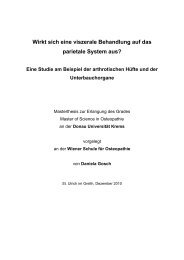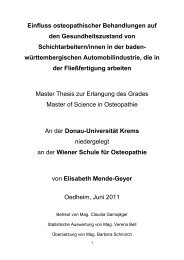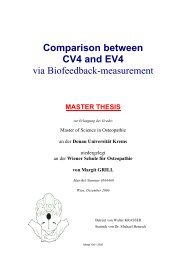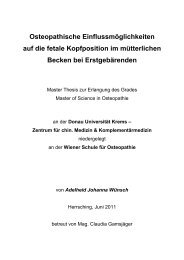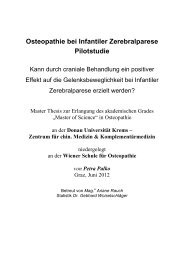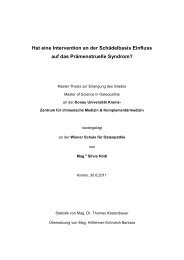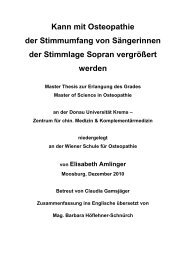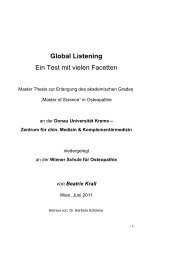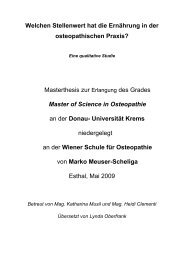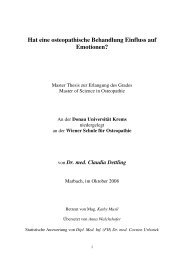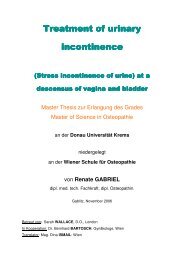Risch Andreas.pdf - Osteopathic Research
Risch Andreas.pdf - Osteopathic Research
Risch Andreas.pdf - Osteopathic Research
Erfolgreiche ePaper selbst erstellen
Machen Sie aus Ihren PDF Publikationen ein blätterbares Flipbook mit unserer einzigartigen Google optimierten e-Paper Software.
for osteopaths to integrate subjective sensory experience (e.g. with the hands) into<br />
osteopathic professionalism (e.g. in interdisciplinary communication) and to resolve<br />
the dilemma of finding the right distance (e.g. to subjective perception), without losing<br />
association or wholeness (e.g. with the osteopathic therapeutic process) and on the<br />
other hand to follow principles and guidelines (e.g. evidence based criteria), without<br />
losing flexibility and the readiness for change (e.g. individual adaption).<br />
Riemann is explaining his model with the metaphor of the earth turning around the<br />
sun as the concept of “association” or social integration and the earth turning around<br />
itself as the concept of “dissociation” or the process of individualization. In addition he<br />
compares the centripedal force or gravity as the concept of “duration” or „holding on“<br />
and the centrifugal force as the concept of “change” or „letting go“. For him these are<br />
the main forces – generating basic forms of “angst” as he calls it - which govern our<br />
existence and guide us between these antinomies. According to Riemann the health<br />
of a person depends on the right balance between these dimensions (Riemann,<br />
1989).<br />
In this metaphor analysis emphasis on bio-mechanical or technical aspects of<br />
osteopathy was less dominant (10%, “STC”) as most education and training<br />
programs would suggest. A preference of metaphors of PROCESS, PATTERN, and<br />
REGULATION” over “FUNCTION and MECHANISM” in the technological category<br />
leads to the conclusion that with increasing professional experience the structural<br />
bio-mechanical and technical model become less prevalent in the concepts of expert<br />
osteopaths. This needs to be further investigated in future studies.<br />
The top category of „rules and regulation“ (12%, HEALTH AS ALLOWANCE,<br />
ACCEPTANCE, TOLERANCE, CONDITIONS) for social/psychological/ethical<br />
understanding of health related to osteopathy is pointing to a „normative“ handling of<br />
these aspects modified by a variety of other categories. This field seemed to be very<br />
important to all interviewed osteopaths explicitly requesting more attention to it in the<br />
education and training programs to gain a better understanding of these aspects.



